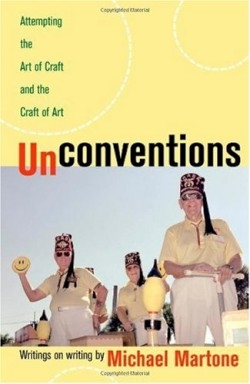Unconventions
Attempting the Art of Craft and the Craft of Art
Writer Peter Turchi calls this volume “a book for writers to turn to when all the handbooks and guides sound too familiar.” Generally speaking, writing books do have rather a lot in common, not so different, in their way, from books on English grammar. Turchi’s own Maps of the Imagination: The Writer as Cartographer is an undisputable exception, and so is this book. The author is certifiably unconventional—a young man who truly marches to the beat of a different drummer, as he demonstrated a few years ago in a Labor Day parade in Tuscaloosa, Alabama, as the sole representative of the National Writers Union.
Martone, a professor of English and director of the creative writing program at the University of Alabama, has discovered that his mostly inoffensive aberrations aren’t handicaps at all for a writer who revels in nonconformity and delights in avoiding excessive seriousness. Among his better-known works is The Blue Guide to Indiana, an ersatz travel book that describes bizarre, imaginary destinations, exemplifying one of Martone’s interests as a writer and teacher of writing: the concept of “passing”—of fiction passing as nonfiction.
“Framing” is another aspect of his role as a producer of art. “I am not simply the creator of objects,” he writes, “but also the creator of the contexts in which those objects are created and displayed, show forth, and do work.”
In a chapter titled “The History of Corn,” Martone presents an informed appreciation of post office murals, which he characterizes as being “predominantly narrative.” Describing their purpose and composition, he explains how writers can make use of their example. One way is to understand the importance of the “ground situation”—or enriched setting, not just the physical details of place and time but how a particular place and time “add to the physics of characters in conflict.”
He devotes further attention to things that enrich settings in a chapter called “Appliances: Domestic Detail and Describing Rituals of the Ordinary,” in which he describes his interest in the character of new appliances like baby monitors and dishwashers, in “their secret histories and their ability to influence, subtly and profoundly, that action happening between people, real and imagined.” This leads him to “the effect of the blender upon the great verities” and “a digression on the domestic landscape.” He explains, too, why the physical structure of a home so profoundly impinges on the relations of its inhabitants, and he recalls that Vladimir Nabokov rendered a detailed floor plan of the Zamza home in Kafka’s Metamorphosis, considering his visualization crucial to his reading of the story.
Such is *Unconventions—*a splendid little handbook for writers that is like no other, one that suggests different ways of looking at matters pertaining to writing and different ways of thinking about them; stimulatingly unconventional.
Reviewed by
Harold Cordry
Disclosure: This article is not an endorsement, but a review. The publisher of this book provided free copies of the book to have their book reviewed by a professional reviewer. No fee was paid by the publisher for this review. Foreword Reviews only recommends books that we love. Foreword Magazine, Inc. is disclosing this in accordance with the Federal Trade Commission’s 16 CFR, Part 255.

